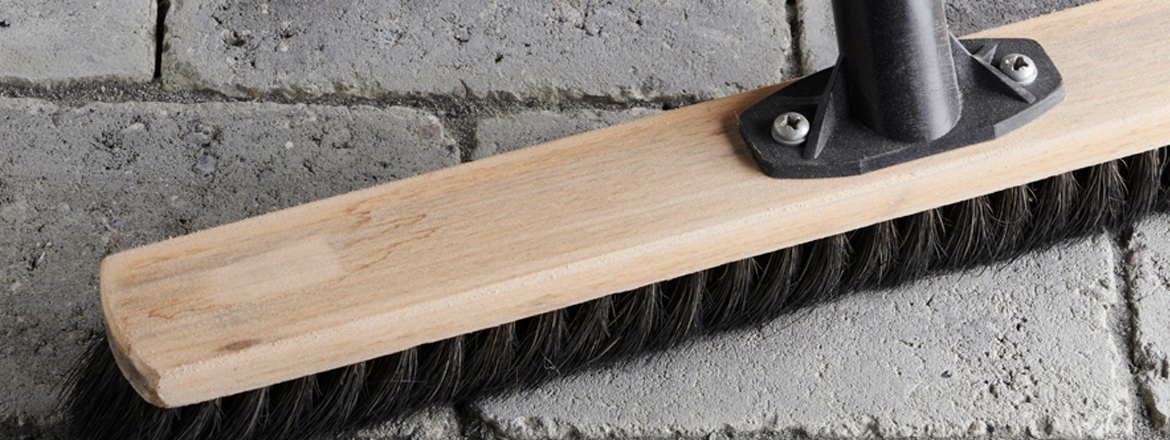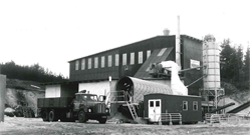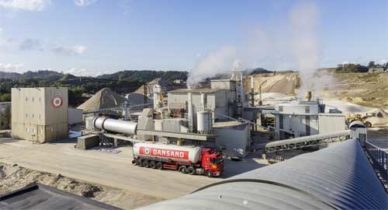Tips about DANSAND® stone dust
Find tips and tricks on this page.

Effect
The washed and dried filling material consists of crushed Norwegian granit with a mineral additive with a naturally low pH-value. This creates a low-nutrition environment in the joint in which weeds will not be able to set root.
Dansand® stone dust does not prevent moss and algae from forming. These will form in joints that are constantly moist or in shaded areas. We recommend the use of a suitable product designed to prevent moss and algae. As an alternative you can scrape out the existing joints with a suitable tool and refill the joints with Dansand® stone dust.
You can minimise the formation of moss and algae by ensuring that the joints are always filled to the top with Dansand® stone dust.
Application
The amount of sand in the joints will gradually reduce over time due to rain or traffic on the paving – particularly if the joints are too wide. You will get the best result by maintaining the recommended joint width of 3 – 20 mm and a depth of 40 mm as a minimum.
Always mix the content of each bag with a shovel before applying the product. During transportation, minerals and fine stone dust may separate in the bag. Never mix the contents of more than two bags at a time.
The paving needs to be perfectly dry before you begin sweeping the joint filling material into the joints. We do not recommend that you leave the stone dust on the paving stones. New paving stones may be coated and the sand may harm the coating. Also, the lime and mineral content in the filling material may leave a whitish coating or efflorescence on the paving stones.
Sweep the paving stones using a soft broom.
It is critical that you compact the filling material from the very beginning in order to secure the longevity and the full functionality of the joints.
If you do not compact the filling material with the use of a vibrating plate, the filling material will subside in the joint, and you will need to refill the joints after a short period of time. Joints should always be filled to the top.
Tip: Use a rubber mat under the vibrating plate to protect the paving.
You will only get the desired weed-control effect if the stone dust is pure and unmixed. Do not mix it with other materials such as cement or other types of sand.
Application areas
Dansand® stone dust is not suitable for clinker tiles or paving tiles. There is a risk of efflorescence on the tiles if you do. Hard-burnt tiles will absorb moisture from the silica sand in the filling material. Combined with the weed-inhibiting mineral in the stone dust, mineral salts will seep into the tiles causing efflorescence. Since the minerals are designed to inhibit weed growth for as long as possible, the efflorescence will take a long time to disappear.
The plaster used for plinths is typically more porous than paving stones. This means that the plaster may absorb salts from the filling sand, leading to efflorescence which cannot be washed off. When filling joints up against the plinth, you should use a neutral filling sand. Weeds rarely grow up against the plinth, since the drier environment close to the house itself gives them poor growth conditions.
You can use Dansand® stone dust in covered areas such as a car shelter or a covered patio. However, since these areas are free from rain, excess salts and minerals from the filling material may migrate to the surface of the joints, causing white efflorescence. This typically happens in spring or summer, aided by warmer air. Efflorescence can also emerge on the edges of the paving stones.
Unlike efflorescence on the house plinth, such efflorescence can be swept or washed off. During warmer periods, it may reappear. If you persist in cleaning it away, it will eventually fade as the mineral content of the filling material declines.
You should only use Dansand® stone dust on an unbound surface, ie. a substrate of sand and gravel on top of raw soil.
All our NO GROW™ filling materials are water permeable and require drainage. A bound substrate, such as concrete or wood, will retain moisture, rendering the binding agents inactive. As a result, the joint will not harden. The paving material will also appear wet and whitish in colour.
No. Dansand® stone dust is not suitable for areas adjoining swimming pools. Water splashes may lead to the stone dust getting into the pool itself or onto the paving.
Problems
The white haze – or efflorescence – is caused by mineral salts. It is a natural phenomenon that often occurs during warm periods such as spring or early summer. The combination of moist air and heat will draw salts on to the paving. The moisture may stem from wet substrate due to heavy rain. Rain will eventually wash the efflorescence away, but normal traffic and/or cleaning may also remove it.
Efflorescence on the paving stones: This may be caused by the paving stone material itself or by having a bound substrate. See
What happens if I use DANSAND joint filling sand on a bound surface?
There are essentially two types of weeds: Weeds that spread through a root network, and airborne weed seeds that settle in the joints.
Weeds that spread through a root network:
Before filling your joints with Dansand® stone dust, be sure to remove all existing weeds and their root network. Dansand® stone dust is not a weed-killer; it creates a poor growth environment for weeds so that seeds cannot set root. Due to the high pH value (approx. 10.4), roots will simply dry out.
Airborne weed seeds: To avoid airborne seeds from setting roots, ensure that the joint is filled in its entire height – 20 mm minimum. Joints should always be filled to the top, so remember to top up the joints from time to time and to keep the paving surface free from dirt and leaves.
Maintenance and cleaning
Absolutely – this is how you keep your joints clean and long-lasting. You also protect your paving in this way, avoiding subsidence, edge peeling, frost damage and so forth.
Always ensure that the joints are filled to the top with filling material. Keep them free from grass, dirt, leaves and other organic matter. Sweep your paving regularly and top up the joints when needed.
Tip!
Inspect your joints in early spring and assess what needs to be done. Is it sufficient to top up the joints or do you need a more thorough renovation?
We recommend three different approaches – read about it here
Safety and environment
Yes. All our NO GROW™ filling materials are free from harmful substances. Dansand® stone dust is made entirely from silica sand, natural high pH minerals and a natural binding agent.
Using a DANSAND® NO GROW™ filling material in your joints means waving goodbye not just to hard work – you can also wave goodbye to harmful chemicals.






